Guzheng Styles
Source: Guzheng(s) by bmeabroad, used under BY-NC-SA 2.0
Guzheng Styles
Jump to: Modern Varieties: Bridges | String Counts | Size | Multi-Tone | Other
Pre-Modern Varieties: 18 String, Steel | 16 String, Steel | Key Modulated | Pedal Modulated | Historic
You'll find the 21-string guzheng everywhere you search for 古筝 but there's more to the story. Here's a look of variants you might encounter in your own musical journeys. If you encounter any we haven't covered, and isn't on the Other Zithers page, email G筝A with pictures and we'll take a look!
Modern Varieties
The most common variants host changes to the shape of the fixed bridges, the number of strings, or the overall size of the instrument.
Most Popular
Bridge Variants
While the S-Bridge is the most common bridge shape it's not the only one. Modern instruments feature C-Bridges, separated bridges, and diagonal bridges. They all accomplish the same basic task: Allowing bass strings to be longer and treble strings to be shorter. Below are examples of a few.
String Variants
The vast majority of modern guzheng have 21 strings but modern makers produce smaller quantities of instruments with 18, 23, 26, and other string counts.
Size Variants
There are roughly four classes of instrument size. From longest to shortest they are Full Size, Travel, Baby, and 'Toy', which is a bit of a catchall term. There's also a fifth pseudo category I'll term 'practice'. The first three sizes can still sound quite nice. The fourth can sound pleasant while the fifth is a musical crime. Read more below.
Full Sized
These instrument come in at about 64 inches, give or take about 2 inches (~162cm +/- 5cm). Thanks to the advantage of their size they have better sound than their smaller counterparts. Full-size instruments can include any of the string or bridge variants.
Travel-Sized
These instruments are shorter than a full size but longer than 50 inches, give or take a few inches (~127cm). While instruments of all sizes have been made throughout the centuries the modern branding of instruments as "travel" guzheng suggests that they fit in a modern car with limited effort. This reduces the hassle of traveling with them. 50 or so inches seems to be about the sweet spot for retaining most of a full-sized instrument's depth and complexity of sound and string spacing while still fitting in a car's back seat.
Baby
Baby guzheng are even smaller than Travel instruments. Coming in at less than 50 inches (127cm) they are even easier to transport but give up more of the depth of sound and the ease of play. Bridge positions and string tensions can shift enough to cause trouble for those used to larger instruments. Baby Guzheng can still sound lovely, though their sounds lack the richness of larger instruments.
Toy
Typically about a foot or two long (30-61cm) Toy guzheng are just that - they may look the part, but they won't have 21 strings nor sound with the same power. They can be a source of joy for all ages and could well turn new generations onto the instrument. The only problem with toy guzheng come from sellers suggesting they are equivalent to a full size. A tourist may bring one home on the promise that proper tuning will unlock the instrument's hidden potential. Sadly, this is not the case.
'Practice' Tools
So these... objects... are pretty common on internet stores like Amazon, eBay, Taobao, and Alibaba. They don't even try to look like a guzheng, instead opting for the simplicity of a horizontal board with strings across it. These devices are typically just an octave or so in width and maybe 8 or so inches long (20cm). They claim to be a practice aide or finger strengthening device. In reality they are more harm than good. They encourage bad or out and out incorrect form that WILL cause you problems when you transition to a real instrument. The strings make a terrible sound when you strike them. Under no circumstances should anyone buy one of these ever. Avoid avoid avoid. You'd be better off with a toy guzheng.
If I experience a practice device that does manage to get it right I'll change my tune. Until then I'm firmly against them.
Multi-Tone Zhengs
The ever-present 21-stringed S-Bridge guzheng may be the most popular but craftsmen sill explore what can be done with new materials and modern technologies. Behold three designs that stretch the instrument almost into a class of their own. Their main focus: Providing players access to more than 21 notes on open strings.
Electric Guzheng, Ensembles, and Sculptures
A guzheng is a work of art so it's no surprise it inspires artistic remixes itself. Below are a few examples captured at the annual China Music instrument show in Shanghai. But first, a special mention.
Mid and Late Twentieth Century
The zheng has changed a great deal in the last 50 years. You can still find used instruments in a huge variety of styles. Most of these aren't produce anymore, and those that are are made in much smaller numbers. Take a look and explore all that you can find!
16 Steel Strings
The guzheng used to be made with bare metal wire for strings and typically featured just 16 strings, or 3 octaves +1 note. The samples shown here are made in Taiwan which adds an extra wrinkle. The guzheng developed on its own path in Taiwan due to a policy of limited interaction between the conflicting groups after the Chinese civil wars ended in 1950. That delayed the spread of guzheng with S-bridges and 21 nylon strings for several decades. Taiwanese designs held to older sensibilities for quite some time.
18 Steel Strings
In a similar vein as the 16-string instruments from Taiwan, below are two 18 Steel String instruments that both happen to come from Hong Kong. The new instruments evolving in Shanghai and other cities spread to Hong Kong before they did Taiwan, leading to some very interesting combinations of new and old. Take a look.
Modulated Zhengs
Pre-1984 modulated zheng. Source: Royal Museum of Art and History, Brussels, Belgium
During the instrument reforms of the 20th century instrument makers tried to address issues musicians had with their instruments. One issue was the need to reposition bridges to switch to a different key. It's a time consuming action that must either be done between songs or by having multiple zheng involved in a performance. What if key changes could be faster? Enter the Modulated Zheng. Various mechanisms were added to the head of the instrument to change the pitch of multiple strings all at once. One common method was to change the tension of the strings.
Unfortunately the mechanisms made the instruments heavier, increased their maintenance costs, were more complicated to produce, and had the unfortunate side effect of detuning the instrument overtime. While significant development occurred through the 1970s the modulated zhengs fell behind the 21-string guzheng in terms of popularity. I've found one for sale in California but otherwise they are relatively rare. Why pay more money for a heavier instrument that has its own complications when you can buy a simpler instrument with better sound for less?
Timeline of Modulated Zhengs:
Work continued. Just as a Celtic lap harp has one place in society and a pedal-actuated concert harp has another, instrument designers saw an opportunity to create zhengs for different roles. Perhaps the advantages of mechanical modulation could justify additional weight and complexity. And so were made:
Pedal-Modulated Zhengs
Worthy of its own mini-timeline is the pedal-modulate zheng. Inspired by western concert harps, zheng makers attempted to add the harp's range and techniques to the humble zheng. Pedal-zhengs stood on special pedestals instead of stands. Mechanisms hidden in the pedestal and head of the zheng would change the tension on the strings, shifting their pitch. This sped up the process of adjusting the zheng's tuning, and models with increased string counts and diatonic tunings were created to emphasize those gains. Unfortunately, the tuning mechanism would shift the movable bridges overtime, ultimately requiring a laborious re-tuning process. Here are some examples:
Historical Zheng
Finally, here are a few zheng found in museums that predate our modern times.

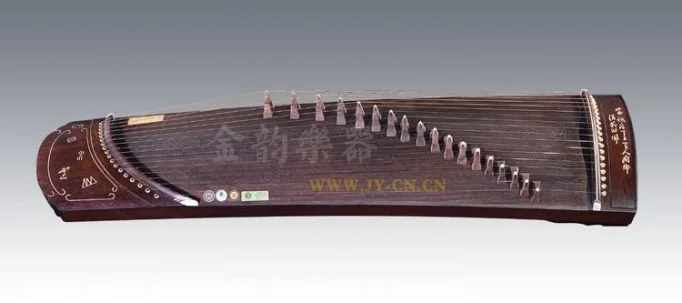








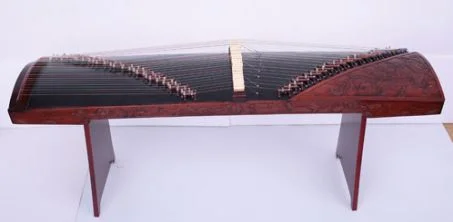
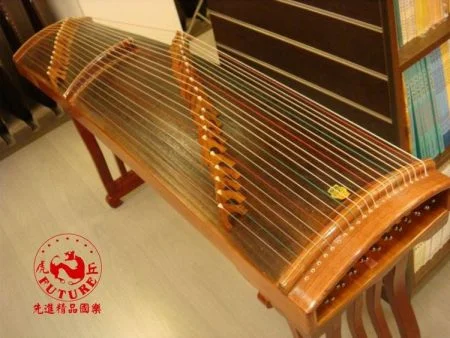

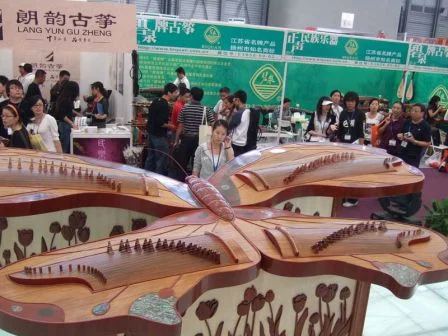


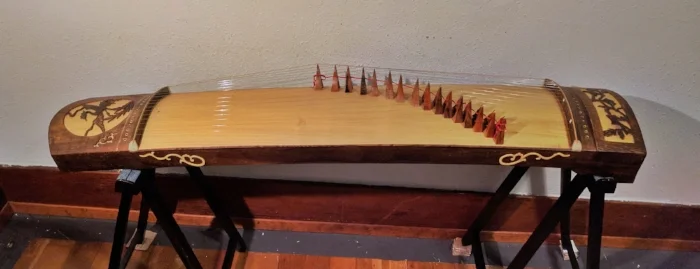










This here is a modern, full-sized guzheng with 21 nylon-coated steel strings, with the bass strings wound in copper. The fixed bridge on the right is straight while the one on the left is curved into an S. The tuning pins are in a compartment at the head of the instrument. The tail is where the strings are anchored.